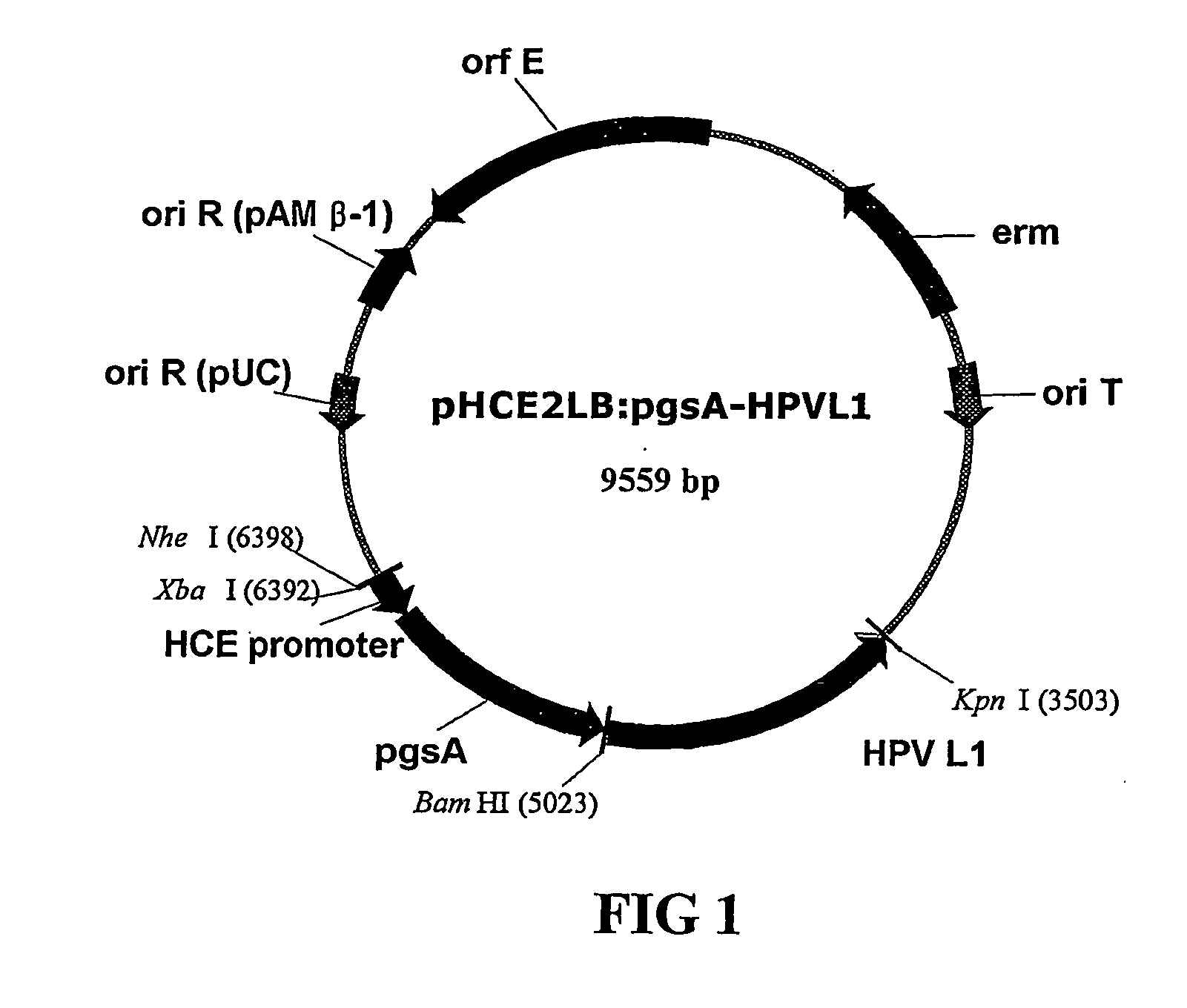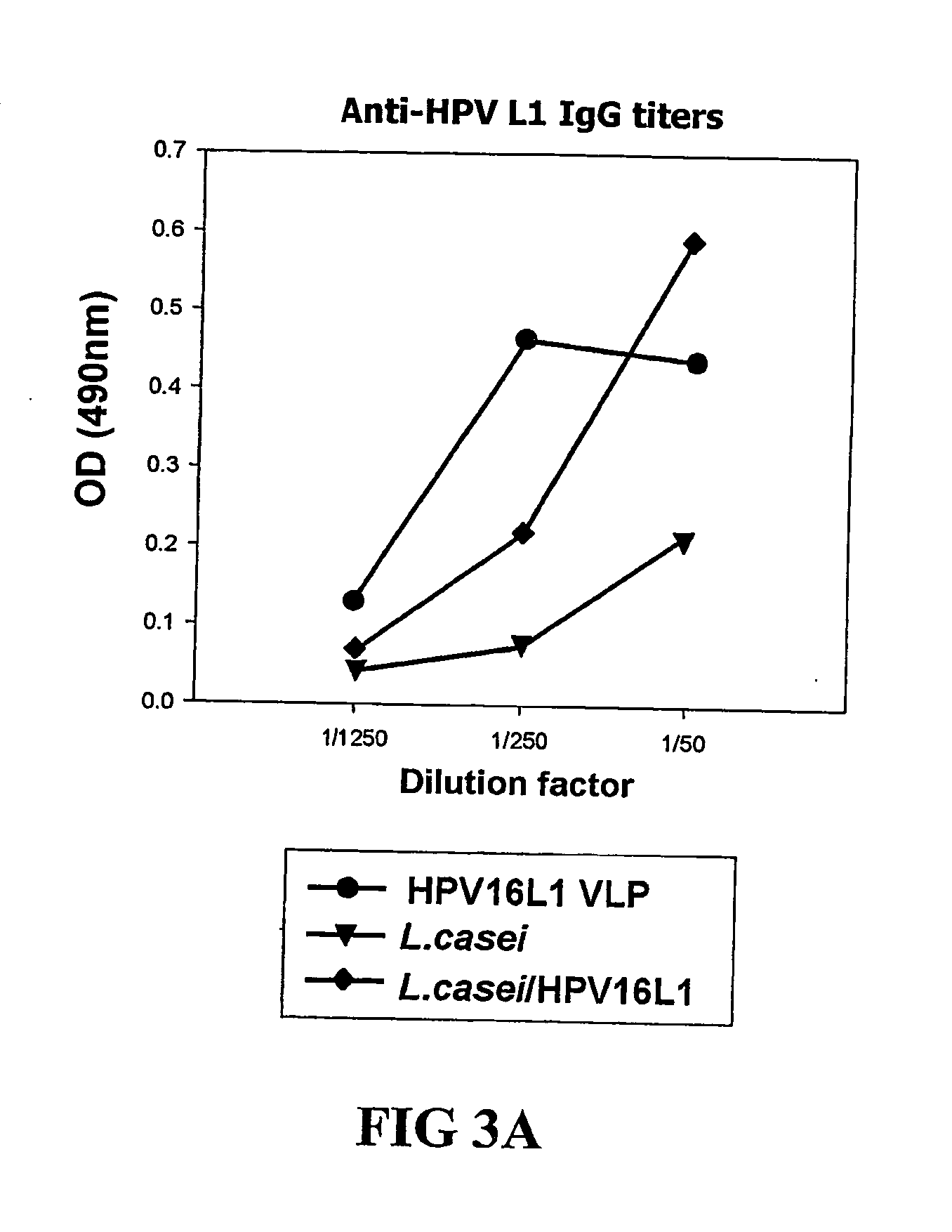Vector for anti-hpv vaccine and transformed microorganism by the vector
a technology of vectors and microorganisms, applied in the direction of viruses, peptides, drugs, etc., can solve the problems of high overall cost, high cost, and excessive viral proliferation, and achieve the effect of reducing the number of viral infections, and provoking the proliferation of viruses
- Summary
- Abstract
- Description
- Claims
- Application Information
AI Technical Summary
Benefits of technology
Problems solved by technology
Method used
Image
Examples
example 1
Construction of the Recombinant Vector pHCE2LB : pgsA: HPV L1 for the Surface Expression
[0053] Cell outer membrane protein derived from Bacillus sp. strain and participating in the synthesis of poly-χ-glutamate is exploited. Among the cell outer membrane gene, pgsBCA, gene pgsA was used to prepare the recombinant vector pHCE2LB:pgsA-HPV L1 which can express the major capsid protein L1 of human papilloma virus Type 16 (hereinafter, referred to as “HPV”) onto a cell surface by using Gram negative bacteria and Gram positive bacteria as a host cell.
[0054] Above all, the gene encoding HPV L1 is introduced into the surface expression vector pGNA which uses Gram negative bacteria as a host cell (obtained from an applicant of Korean Patent Application No. 10-2001-48373). Precisely, approximately 1.5 kb of human papilloma virus gene cloned in pUC19 was utilized as a template and oligonucleotides encoding HPV L1 and containing the nucleotide sequence of SEQ ID. NO. 4 or SEQ ID. NO. 5 as a t...
example 2
Surface Expression of HPV L1 Fused with pgsA
[0058] Gram negative bacterium Salmonella typhi Ty21a was transformed with the recombinant vector pHCE21LB:pgsA-HPV L1 for the surface expression described above and examined the protein expression of HPV L1 antigen fused with pgsA in Salmonella typhi Ty21a. Then, Gram positive bacterium Lactobacillus was transformed, identified the presence of the recombinant vector pHCE21LB:pgsA-HPV L1 within Lactobacillus strain and examined the protein expression of HPV L1 antigen fused with pgsA (See FIG. 2). The bacterial expression of HPV L1 antigen associated with the C-terminus of pgsA gene participating in the synthesis of poly-χ-glutamate was examined by performing SDS-polyacrylamide gel electrophoresis and western blotting with specific antibodies against HPV L1.
[0059] Concretely, Salmonella typhi Ty21a transformed with the recombinant vector pHCE2LB:pgsA-HPV L1 was cultured onto 500 mL flask including 50 mL of LB medium (yeast extract 5 g / L,...
example 3
Induction of Immune Reaction in Lactobacillus Expressing HPV L1 Antigen Onto Cell Surface
[0062] The recombinant vector pHCE2LB:pgsA-HPV L1 for the surface expression was transformed to Gram positive bacterium, Lactobacillus casei, induced to express the antigen onto cell surface of Lactobacillus casei as described in Example 2 and then the cell outer membrane protein pgsA participating in the synthesis of poly-χ-glutamate and the HPV16 fused with L1 antigen were examined for the antigenicity.
[0063] Concretely, the recombinant vector pHCE2LB:pgsA-HPV L1 of the present invention was transformed to Lactobacillus casei for the surface expression, harvested to adjust each cell to the same concentration and washed several times with PBS buffer (pH 7.4). Then, Lactobacillus in which HPV16 L1 antigen is expressed onto cell surface and Lactobacillus not transformed were administered in 5×1010 bacteria to an oral cavity of 4˜6 week BALB / c mouse, three times every other day in the first week...
PUM
| Property | Measurement | Unit |
|---|---|---|
| pH | aaaaa | aaaaa |
| pH | aaaaa | aaaaa |
| pH | aaaaa | aaaaa |
Abstract
Description
Claims
Application Information
 Login to View More
Login to View More - R&D
- Intellectual Property
- Life Sciences
- Materials
- Tech Scout
- Unparalleled Data Quality
- Higher Quality Content
- 60% Fewer Hallucinations
Browse by: Latest US Patents, China's latest patents, Technical Efficacy Thesaurus, Application Domain, Technology Topic, Popular Technical Reports.
© 2025 PatSnap. All rights reserved.Legal|Privacy policy|Modern Slavery Act Transparency Statement|Sitemap|About US| Contact US: help@patsnap.com



